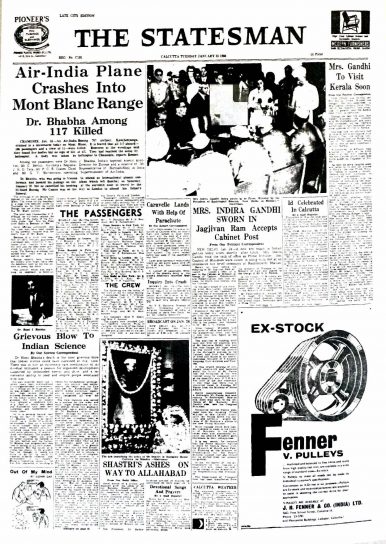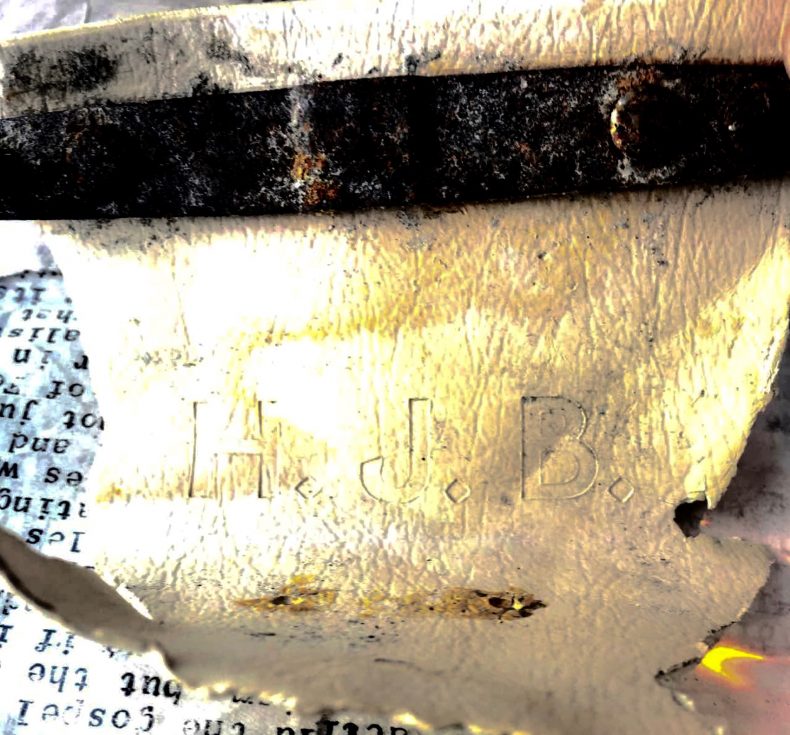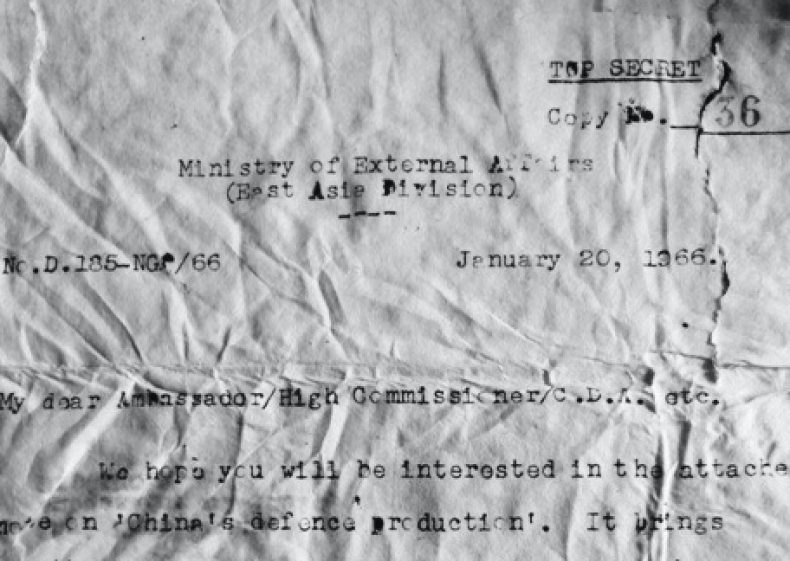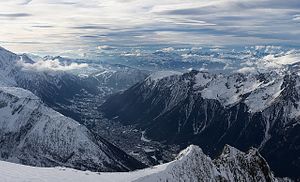On January 24, 1966, at about 7:02 in the morning, Air India 101 ‘Kanchenjanga’– a Boeing 707 airliner– crashed on Mont Blanc near the Franco-Italian border. All 117 people on board were killed, including Homi Jehangir Bhabha, hailed as the father of the Indian nuclear program. His remains were never recovered from the Alps: Vikram Sarabhai delivered his condolences in Bombay (present-day Mumbai) on January 25, and became Bhabha’s successor as the chairman of the Indian Atomic Energy Commission.
In summer 2016, over half a century later, the Bossons glacier in Chamonix, in the French Alps, elicited a series of treasures: not rubies or sapphires but documents marked “Top Secret,” originating from the Indian Ministry of External Affairs and on board the ill-fated Air India flight of 1966. What do these documents tell us? Do they warrant a trip to the Alps for the archive-hungry historian?

Front page of the newspaper The Statesman, January 25, 1966. Image from the book A Masterful Spirit: Homi Bhabha, 1909-1966 by Indira Chowdhury and Ananya Dasgupta.
Two Crashes, One Location
Climate change and the resultant evanescence of the Alpine glacier have been spewing surprises to the inhabitants and mountaineers that visit this certain area in the Alps. According to Françoise Rey, a long-time inhabitant of Chamonix, both human curiosity and avarice have a role to play. “People dig around hoping for jewels from the plane,” and sometimes, “just for cadavers,” she told me during our meeting in Geneva in May 2017.
Rey is a novelist, who has authored several books including the 2015 Crashs au Mont Blanc: La Fin des Secrets? (The Crashes on Mont Blanc: The End of Secrets?) She thinks that a lot can be done about the incessant surprises that the glacier is offering, if only the people who run into jewels, trinkets, government documents, and sometimes human body parts on the glacier, could deposit those into a recognized repository, like, perhaps an “Archive of Mont Blanc Crashes.”
The 1966 plane was not the first Indian airliner to meet its tragic end on the glacier. It crashed into the Bosson glacier exactly in the same area as Air India Flight 245, called the “Malabar Princess,” which had perished in November 1950 with all 48 passengers and crew on board. This 1950 crash inspired renowned French author Henri Troyat’s novel La neige en deuil (literally translated as “The Mourning Cloud”), which was later adapted into the 1956 American film, The Mountain.
The black box from the 1966 crash was never recovered, and rescue operations were halted the day after the crash owing to severe weather conditions around Mont Blanc. Investigation resumed in September 1966, and the French inquiry commission completed its report in March 1967, concluding that severe “white-out” conditions near the summit of the mountain, together with miscommunication over “phraseology” between the air traffic controller in Geneva, and the pilot Captain J.T. D’Souza led to the crash. The French line of reasoning was accepted by the Indian government, and included in its annual report, Accidents to Aircraft Registered in India 1966, produced by the Air Safety Directorate of India’s Civil Aviation Department.
Although the French report noted that the largest parts of the debris from the crash were on the Italian Alps near Courmayeur, it is unclear why Italy did not participate in the inquiry commission. Eyewitness accounts of Italian individuals were, however, incorporated into the French report. These included accounts by Alitalia pilot Agostino Ferrari (AZ 234), Italian Air Force pilot colonel Aldo Sirtori, and pilot Patron (6029), who were flying near the crash site around that time. According to the transcript of communication of the air traffic controller in Geneva included in the French report, Flight 6029 was scheduled to fly over Geneva around the same time as Air India 101 was to make its descent on the Swiss city. As a result, when the latter suddenly disappeared from the radar, the controller asked flight 6029 around 7:04 am to report on what it saw around Mont Blanc. The pilot remarked in Italian that he saw, “a black cloud around 16,000 feet, different from the other clouds,” and he thought that the black cloud was possibly due to an “explosion.” The 1966 crash has engendered numerous conspiracy theories that have titillated generations of Chamoniards and visitors but are beyond the scope of this essay.
Homi Bhabha and India’s Nuclear Latency
The 1966 crash resulted in the death of the man known as the father of India’s nuclear program. The Guardian called Homi Bhabha’s death a loss not just for India but also for the world, which had lost a “scientific diplomat and emissary.” Prior to his death in January 1966, Bhabha played a pivotal role in India’s nuclear program, and often exaggerated India’s ability to develop a nuclear device. In late 1964, after the first Chinese nuclear test, Bhabha claimed that India could explode a nuclear device within 18 months, and for a cost of $10 million.
During his meeting with U.S. officials at the State Department in February 1965, he claimed that “India needed to make some dramatic ‘peaceful’ achievement to offset the prestige gained by communist China among Africans and Asians.” Referring to India’s indigenously built plutonium reprocessing plant, Bhabha told bewildered U.S. officials the plant was “large enough to process all of the plutonium from the reactors India is now building,” and that within five years, “India could produce hundred nuclear bombs per year.”
In other words, Bhabha was “hedging” for India given New Delhi’s nuclear latency, manifest in its fissile material production capability at the time. The latter half of the 1960s was a pivotal phase in the trajectory of India’s nuclear program, as I have argued elsewhere. It is no surprise, therefore, that in its obituary for Bhabha, the London-based Times remarked on India’s nuclear weapons potential: “The Indian government has therefore, provided itself with the option of producing plutonium bombs if it so desires in the future.” At the memorial lecture in Bhabha’s honor at the Royal Institution in London, a year later, Sir John D. Cockcroft, former director of the U.K. Atomic Energy Research Establishment, and Bhabha’s colleague from the Cavendish laboratory in Cambridge, stated:
In later years, Homi Bhabha became a central figure in the discussions on proliferation of nuclear weapons, and on the issue as to whether India should develop such weapons. At this time, it was a declared policy of the government of India not to develop nuclear weapons, and Homi Bhabha of course in his official pronouncements followed the policy of his government. However, I always thought, from private discussions, that his attitude was somewhat ambivalent. After the Chinese nuclear bomb test, he certainly wished to put India into the position of being able to make plutonium bombs, if the government so desired.
At the same meeting of the Royal Institution, M.G.K. Menon, who had become the new director of the Tata Institute of Fundamental Research, argued that Bhabha’s decision to set up the plutonium reprocessing plant in India “has sometimes been misunderstood,” and that the matter ought to be put in the “right historical perspective.” Menon argued that because New Delhi’s decision to build the reprocessing plant was made prior to the 1962 Sino-Indian war, the plant was for reprocessing fuel rods and not nuclear bombs. However, Menon did not mention that mistrust between India and China had been public since Beijing’s 1950 occupation of Tibet, and that border tensions existed between the two countries prior to the 1962 war. More importantly, India knew of the fast advancing Chinese nuclear weapons program before its war with China in October 1962.
In any case, Bhabha’s untimely death on Mont Blanc came at a complex time for India: the country was mourning the death of Prime Minister Shastri, who had recently passed away while visiting Tashkent to sign a peace treaty with Pakistan in the wake of the 1965 war, and a young and relatively inexperienced Indira Gandhi took the reins of an economically struggling country.

Section of a folder with Homi Jehangir Bhabha’s initials: H.J.B. Credit: Francoise Rey
Documents “Declassified” by the Glacier
Official Indian documents from early 1966, if properly recovered from the Bosson glacier, could shed light on a series of issues concerning India’s foreign policy, diplomacy, and nuclear program at the time. According to Rey, the documents found in summer 2016 are of classification “A” (top secret) and “B” (official communication). Some of the documents that she showed me during our meeting in Geneva were indeed marked “Top Secret.” Some originated from the East Asia Division of the Indian Ministry of External Affairs, and concerned Indian assessments of Chinese defense production, missile development, and nuclear weapons program. Some documents were meant for the Indian Ambassador Khub Chand in Stockholm, while others were for Indian embassies and high commissions more generally.
One such Indian document from January 20, 1966 on China’s military assessment noted with frustration, “While every attempt has been made to make the estimates as objective and as accurate as possible, it has not been possible to leave out the speculative element completely because of the total absence of official statistics.” Another assessment document on Chinese nuclear delivery capability stated: “By the end of 1966, the size of the bomb could be reduced so that it becomes deliverable by an IL-28 light bomber. By the middle of 1967, China could have a nuclear-armed missile with a range of 1,000 miles.”
One document marked “Secret” was an analysis entitled “China and the West,” which argued that Beijing was aware “that she is no longer treated as a sick giant but commands a healthy respect and a welcome fear from Western Europe.” It is likely that the French recognition of China in 1964, and low-level meetings between West German and Chinese officials in Geneva exploring the possibility of diplomatic relations, along with the muted criticism of Chinese nuclear test, enhanced Indian anxieties of losing to China’s rising significance in the international system. A French historian has herself recently seen some of these official documents from under the glacier, and described her experience here.

Section of a top secret document from the Indian Ministry of External Affairs dated January 20, 1966. Credit: Francoise Rey
In August 2012, rescue worker Arnaud Christmann found a bag containing diplomatic mail from the Indian Ministry of External Affairs, which he turned over to the police in Chamonix. The jute bag, weighing about 9 kilograms (19.8 pounds), contained newspaper reports from January 1966 that were found largely intact, and was promptly returned to the Indian Embassy in Paris.
Not every item obtained from the crash site is, however, returned. Unfortunately, these official documents from Air India 101 are scattered in residential homes in Chamonix and elsewhere. The documents scavenged from the melting glacier in Chamonix could be a treasure trove of archival evidence for the Cold War historian. At the same time, these could also constitute a disappointing mirage. Most of these documents are in bits and pieces. They are not in proper sequence, and the exact identities of the individuals who carried these documents on the fated Air India 101 “Kanchenjunga” are impossible to establish.
Rey only has a handful of these documents. The rest are buried under the glacier, and some are with other Chamonix dwellers, treasure-hunters, and Alpine climbers, who have stumbled upon these archival materials by sheer chance. Rey regrets the lack of awareness of the historical significance of the documents among some of her fellow residents. People dig for jewelry, and when they find documents, they often discard them. Treasures did emerge from the crash site in the past, as in 2013 and 2014, therefore attracting those largely motivated by greed. Yet, at the same time, many of these documents, which are over 50 years old, are in remarkably good shape, as if deliberately preserved by the glacier.
In other words, the Bossons glacier holds at least some promise for historians. A people’s repository— an “Archive of Mont Blanc Crashes”— might be the right step forward from here.
Jayita Sarkar is a historian, and will join Boston University’s Frederick S. Pardee School of Global Studies as assistant professor of international relations in August 2017.

































